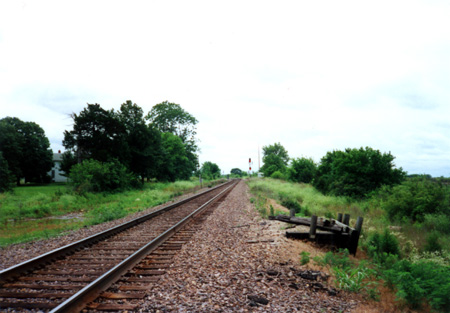Jack E. Randorff- 806-789-2176
Randorff and Associates
11 West Canyon View Dr.
Ransom Canyon, Texas 79366
Popular version of paper 3pAA5
Wednesday Afternoon, November 12, 2003
146th ASA Meeting, Austin, TX

Drivers approaching railroad crossings may or may not be able to hear the train horns in enough time to stop their cars or trucks safely. Why not? Many factors are involved. Was the train horn loud enough? Was the train horn blown with enough time to react? Were buildings or billboards shielding the crossing from the train horn? Was the radio too loud in the car or truck?
Most states require that motorists yield the right-of-way to trains at highway-railroad grade crossings. One method of alerting drivers to a train at a crossing is to sound an audible warning using an air horn. The federal government sets the minimum loudness that a train horn must blow at each crossing. Yet some people drive as if no warning was heard. Many times these people are killed or maimed for life. Why?
The effectiveness of train horns is greatly misunderstood. Even the National Transportation Safety Board has drawn erroneous conclusions regarding the ability of train horns to alert drivers. It is no wonder that many people, including those sitting on juries, can become convinced that train horns are almost useless. In the courtroom, the effectiveness of a train's air horn to alert the driver of a car can be a crucial element that allows a jury to determine liability and award financial penalties.
Generally speaking, the real issue concerning the loudness of a train's horn only comes into question at unguarded railroad crossings. The crossings without bells, lights and crossing gates are the crossings most subject to courtroom battles. Many times the issue becomes, "Could the driver hear the horn and how soon could they hear it?"
In earlier times, the question about the horn being blown correctly and on-time was a matter of believing the engineer driving the train and witnesses to the accident. However, since the late 1980's, most railroads have equipped their locomotives with blackboxes called "event recorders." These blackboxes record train speed, throttle settings, air pressure, horn usage and emergency stops. Now the question does not involve one person's word against another's. Now the question becomes should the driver have heard the horn and stopped their car or truck before the accident occurred. A further question may be if they failed to stop when the horn was blowing, why did they seem not to hear the horn? This is where scientific gathering and analysis of engineering data are useful.
The loudness of the locomotive air horn must first be measured to determine compliance with the proper Federal Railroad Administration regulation. However, this is just the beginning a proper scientific investigation of audibility. An accurate record must be made of the air horn loudness over a band of frequencies, or audio pitches, so that each frequency, or pitch, may be checked for loudness. This will relate directly to the driver's ability to hear and quickly react to the horn. The accident site must be observed and checked for any obstructions that may have kept the driver from hearing the horn. The same model of car or truck must be tested for its ability to limit the amount of sound that can penetrate inside. The background noise inside the car or truck must be accurately recorded under the conditions most likely existing at the time of the accident. All these factors are combined to determine the remaining loudness of the train horn tones heard by the driver in relation to the background noise inside the car or truck.
Train horns have been designed to produce tones which are particularly known for penetrating inside cars and trucks to be noticed by drivers. These tones can actually be heard beneath the background noise in a car or truck. The overall minimum loudness that the Federal Railroad Administration mandates was chosen with this in mind.
While in most cases it is evident that train horns are effective in getting a driver's attention, why does it not seem to work for some unfortunate drivers? There are times when the answer is that a driver is attempting to beat the train to the crossing. There have been cases where suicide may have been the cause. But in many of the accidents it appears that the drivers have not taken seriously the responsibility to pay attention and then yield right-of-way to the train.
Under that last condition, it is most probable that some drivers are so distracted by the task of driving their cars that hearing the train horn becomes much less important than to drivers who are ready to yield right-of-way. Other research has shown that under these conditions a driver may be so distracted that it takes twice as much sound from a horn to get their attention. This may mean that the train has to be three times closer before the driver hears the tones of the train's horn. Oftentimes this is too late to react and stop before the accident.
In a lawsuit, all of this information must be presented to a jury through the
process of direct and cross examination. The jury decides on the weight of the
scientific evidence whether acoustics played a significant role in the accident.